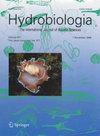Reproductive biology of the sailfish Istiophorus platypterus in the Acapulco Bay, Mexico
IF 0.3
4区 生物学
Q4 MARINE & FRESHWATER BIOLOGY
引用次数: 0
Abstract
Background. The sailfish Istiophorus platypterus is an oviparous billfish species (family Isthiophoridae); it is caught by trolling in the sports fishery in Mexico. However, to date, there have been no reproductive biology studies of sailfish in Acapulco Bay, although the reproductive aspects of any species represent essential information for the design of management plans. Goals. Provide information on aspects of the reproductive biology of sailfish in waters off Acapulco, Bay. Methods. During the period 2008–2009, a total of 561 fish were sampled. Macroscopy analysis and quantitative histology was used to describe reproductive characteristics of the sailfish gonads. Results. 55.8% of the analyzed organisms were males, the remaining 44.2% were females, the sex ratio (1.26 M: 1 H) was different from the expected theoretical ratio. The ovaries of 155 females were classified into five ovarian development phases based on histological analysis of the most advanced group of oocytes. Sailfish is a multiple spawn with asynchronous oocyte development. Batch fecundity for 14 females with the presence of hydrated oocytes ranged from 0.330 to 2.092 × 10 oocytes with an average of 1.07 × 106 oocytes. Gonadosomatic index (GSI) indicated that sailfish have a reproductive period with peaks in August and October (mean monthly GSI= 4.3% and 5.4%, respectively). Conclusions. Population sailfish in the Bay of Acapulco is composed mainly of males, with a reproductive maximum in the case of females during the warm months of the year, as well as a relatively high fecundity.墨西哥阿卡普尔科湾旗鱼的繁殖生物学
背景扁鳍旗鱼(Istiophorus platyptus)是一种卵生的喙鱼(Isthiophoridae);它是在墨西哥的运动渔业中被钓鱼捕获的。然而,到目前为止,还没有对阿卡普尔科湾旗鱼的生殖生物学研究,尽管任何物种的生殖方面都是设计管理计划的重要信息。目标。提供阿卡普尔科湾海域旗鱼繁殖生物学方面的信息。方法。在2008-2009年期间,共对561条鱼进行了采样。采用宏观分析和定量组织学方法描述旗鱼性腺的生殖特征。后果55.8%的分析生物体为雄性,其余44.2%为雌性,性别比(1.26 M:1 H)与预期的理论比例不同。根据对最晚期卵母细胞组的组织学分析,将155名女性的卵巢分为五个卵巢发育阶段。帆鱼是一种卵母细胞发育不同步的多卵鱼类。有水合卵母细胞的14只雌性的批量受精率为0.330~2.092×10,平均1.07×106。性腺体细胞指数(GSI)表明旗鱼有一个繁殖期,在8月和10月达到高峰(平均月GSI分别为4.3%和5.4%)。结论。阿卡普尔科湾旗鱼种群主要由雄性组成,在一年中温暖的月份,雌性旗鱼的繁殖能力最高,繁殖力相对较高。
本文章由计算机程序翻译,如有差异,请以英文原文为准。
求助全文
约1分钟内获得全文
求助全文
来源期刊

Hidrobiologica
生物-海洋与淡水生物学
CiteScore
0.40
自引率
0.00%
发文量
8
审稿时长
>12 weeks
期刊介绍:
HIDROBIOLÓGICA es una publicación cuatrimestral que difunde trabajos originales e inéditos de investigación o revisión, sobre temas relacionados con los organismos y la hidrología de los ambientes acuáticos, dulces y marinos y va dirigida a investigadores de todo el mundo, interesados en las diversas disciplinas que incluye la Hidrobiología , así como a alumnos de posgrados y licenciaturas relacionados con la biología, ecología, taxonomía, filogenia y evolución de organismos acuáticos, e hidrología y oceanografía de ambientes s dulceacuícolas y marinos.
 求助内容:
求助内容: 应助结果提醒方式:
应助结果提醒方式:


